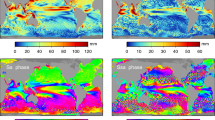Abstract
A method for splitting sea surface height measurements from satellite altimetry into geoid undulations and sea surface topography is presented. The method is based on a combination of the information from altimeter data and a dynamic sea surface height model. The model consists of geoid undulations and a quasi-geostrophic model for expressing the sea surface topography. The goal is the estimation of those values of the parameters of the sea surface height model that provide a least-squares fit of the model to the data. The solution is accomplished by the adjoint method which makes use of the adjoint model for computing the gradient of the cost function of the least-squares adjustment and an optimization algorithm for obtaining improved parameters. The estimation is applied to the North Atlantic. ERS-1 altimeter data of the year 1993 are used. The resulting geoid agrees well with the geoid of the EGM96 gravity model.
Similar content being viewed by others
References
Anzenhofer M. and Gruber T., 1998. Fully reprocessed ERS-1 altimeter data from 1992 to 1995: Feasibility of the detection of long term sea level change. J.Geophys. Res., 104(C4), 8089-8112.
Arent N., 1993. Ein quasi-geostrophisches Stromungsmodell zur Auswertung von Satelliten-Altimeterdaten. Reihe C, 402. Deutsche Geodatische Kommission, Munchen.
Arent N., Huckelheim G. and Koch K.R., 1992. Method for obtaining geoidundulations from satellite altimetry data by a quasi-geostrophic model of the sea surface topography. Manuscripta Geodaetica, 17, 174-185.
Arent N., Huckelheim G. and Koch K. R., 1993. Geoid undulations and sea surface topography in the North Atlantic from altimeter data. In: B. Kaldejch (Ed.), Proceedings Second ERS-1 Symposium-Space at the Service of our Environment, ESA SP-361, ESTEC, Noordwijk, 1065-1070.
Blinken R., 1999. Bestimmung von Geoid und Meerestopographie aus Altimeterdaten mittels der Adjungierten Methode. Shaker Verlag. Aachen.
Denker H. and Rapp R. H., 1990. Geodetic and oceanographic results from the analysis of 1 year of GEOSAT data. J. Geophys. Res., 95(C8), 13151-13168.
Dorny C. N., 1975. A Vector Space Approach to Models and Optimization. J. Wiley & Sons, New York, London, Sydney, Toronto.
Engelis T. and Knudsen P., 1989. Orbit improvement and determination of the ocean, geoid and topography from 17 days of SEASAT data. Manuscripta Geodaetica, 14, 193-201.
Gelb A. (Ed.), 1974. Applied Optimal Estimation. Massachusetts Institute of Technology, Cambridge, Massachusetts, London.
Giering R., 1997. Tangent linear and adjoint model compiler, Users manual version 1.2. http://puddle.mit.edu/~ralf/tamc.
Giering R. and Kaminski T., 1998. Recipes for adjoint code construction. ACM Transactions on Mathematical Software, 24(4), 437-474.
Gill P. E., Murray W. and Wright M. H., 1981. Practical Optimization. Academic Press, London, New York.
Hellerman S. and Rosenstein M., 1983. Normaly monthly wind stress over the world ocean with error estimates. J. Phys. Oceanography, 13, 1093-1104.
Holland W. R., 1978. The role of mesoscale eddies in the general circulation of the ocean-Numerical experiments using a wind-driven quasi-geostrophic model. J. Phys. Oceanography, 8, 363-392.
Huckelheim G., 1994. Parameterschatzung in dynamischen Systemen fur die Satelliten-Altimetrie. Reihe C, 415. Deutsche Geodatische Kommission, Munchen.
Kalman R. E., 1960. A new approach to linear filtering and prediction problems. Journal of BasicEngineering, 82D(1), 35-45.
Koch K. R., 1970. Gravity anomalies for ocean areas from satellite altimetry. Marine Geodesy a Practical View, 301-307. A Second Symposium on Marine Geodesy, 3–5 November 1969, Marine Technology Society, Washington, D.C.
Koch K. R., 1990. Bayesian Inference with Geodetic Applications, Springer Verlag, Berlin, Heidelberg, New York.
Koch K. R., 2000. Einfuhrung in die Bayes-Statistik. Springer-Verlag, Berlin, Heidelberg, New York.
Le Dimet F. X. and Talagrand O., 1986. Variational algorithms for analysis and assimilation of meteorological observations: Theoretical aspects. Tellus, 38A, 97-110.
Lemoine F. G., Kenyon S. C., Factor J. K., Trimmer R., Pavlis N. K., Chinn D.S., Cox C. M., Klosko S. M., Luthcke S. M., Torrence M. H., Wang Y. M., Williamson R. G., Pavlis E. G., Rapp R. H. and Olson T. R., 1998. The development of the joint NASA GSFC and the National Imagery and Mapping Agency (NIMA) geopotential model EGM9G. NASA Technical Paper NASA/TP 1998-206861. Goddard Space Flight Center, Greenbelt, Maryland.
Marsh J. G., Koblinsky C. J., Lerch F., Klosko S. M., Robbins J. W., Williamson R. G. and Patel G. B., 1990. Dynamic sea surface topography, gravity, and improved orbit accuracies from the direct evaluation of SEASAT altimeter data. J. Geophys. Res., 95(C8), 13129-13150.
Marshall J. C., 1985. Determining the ocean circulation and improving the geoid from satellite altimetry. J. Phys. Oceanography, 15, 330-349.
Nocedal J., 1992. Theory of algorithms for unconstrained optimization. Ada Numerica, 1, 199-242.
Rapp R. H., 1989. The treatment of permanent tidal effects in the analysis of satellite altimeter data for sea surface topography. Manuscripta Geodaetica, 14, 368-372.
Rummel R., 1993. Principle of satellite altimetry and elimination of radial orbit errors. In: R. Rummel and F. Sanso (Eds.), Satellite Altimetry in Geodesy and Oceanography. Springer-Verlag, Berlin, Heidelberg, New York, 189-241.
Schwintzer P., Reigber C., Bode A., Kang Z., Zhu S. Y., Massmann F. H., Raimondo J. C., Biancale R., Balmino O., Lemoine J.M., Moynot B., Marty J. C., Barlier F. and Boudon Y., 1997. Long-wavelength and gravity field models: GR1M4-S4, GRIM4-C4. J.Geodesy, 71, 189-208.
Talagrand O., 1991. The use of adjoint equations in numerical modelling of the atmospheric circulation. In: A. Griewank and G. Corliess (Eds.), Automatic Differentiation of Algorithms: Theory, Implementation and Application. SIAM, Philadelphia, 169-180.
Talagrand O. and Courtier P., 1987. Variational assimilation of meteorological observations with the adjoint vorticity equation, Part I: Theory. Quarterly Journal of the Royal Meteorological Society, 113, 311-1328.
Thacker W. C. and Long R. B., 1988. Fitting dynamics to data. J. Geophys. Res., 93(C2), 1227-1240.
Tziperman E. and Thacker W. C., 1989. An optimal-control/adjoint equations approach to studying the ocean general circulation. J. Phys. Oceanography, 19, 1471-1485.
Author information
Authors and Affiliations
Rights and permissions
About this article
Cite this article
Blinken, R., Koch, KR. Geoid and Sea Surface Topography Derived from ERS-1 Altimeter Data by the Adjoint Method. Studia Geophysica et Geodaetica 45, 235–250 (2001). https://doi.org/10.1023/A:1022080011849
Published:
Issue Date:
DOI: https://doi.org/10.1023/A:1022080011849




